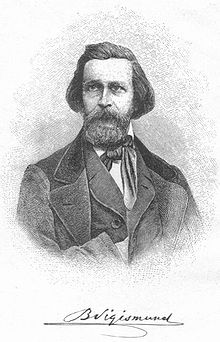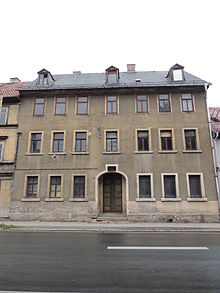Berthold Sigismund
Berthold August Richard Sigismund (born March 19, 1819 in Stadtilm ; † August 13, 1864 in Rudolstadt ) was a German doctor , educator , writer , poet and politician .
Childhood and youth
Berthold August Richard Sigismund was born as the first child of the notary and later Justice Council Florence Friedrich Sigismund (1791–1877) in Stadtilm at the foot of the Thuringian Forest . His great-grandfather was a school teacher in Schmalenbuche , his grandfather a teacher in Schwarzburg , later in Schmalenbuche and finally in Blankenburg . His mother was the daughter of the late Mayor Fischer in Blankenburg . There were seven children from this marriage. According to his father, Berthold is said to have been "wild, questioning, eager to learn, but soft-hearted, with a great interest in nature" as a child.
In 1829 the family moved to Blankenburg, where their grandparents lived, for professional reasons. Berthold attended grammar school in Rudolstadt and learned Hebrew and English on the side. In 1837, after graduating from high school, he decided to study medicine at the University of Jena . There he discovered his talent for drawing and painting, as well as music, played the piano and wrote his first poems. The death of his tuberculosis brother shortly before Christmas 1839 shook him so deeply that he stayed in Blankenburg for the winter. During this time he met Friedrich Froebel , who was setting up his first kindergarten in Blankenburg, and also took part in his lectures. In 1840 he moved to the University of Leipzig . From 1841 to 1842 he spent his last year of study at the University of Würzburg . There he obtained his doctorate in medicine . In Rudolstadt he passed his medical state examination with honors before the medical examination board.
Professional background
At the age of 23 he settled as a doctor in his hometown of Blankenburg, but soon realized that he could not find a living among the poor population. In addition, the first health problems made themselves felt. In July 1843 he traveled via Saalfeld , Sonneberg , Coburg , Bamberg , Nuremberg , Donauwörth to Augsburg and Munich . From there he migrated via Zurich to Lenzburg near Aargau in Switzerland to teach there as a private tutor. In his free time he devoted himself more to scientific and medical literature. The liberal institutions of the Swiss Republic also attracted him. His democratically-minded compatriot, Prof. Julius Froebel , who stayed in Zurich for a time, had an influence on him.
In September 1844 he took a teaching position at a private school in Worksop near Sheffield . There he mainly taught natural sciences, anthropology and the German language. At the Mechanics Institute in Derby , he gave a lecture in English on the human and animal vocal organs in front of an audience of around 400. In July 1845 he returned to Thuringia, made a brief stop in Paris, where he acquired further medical knowledge by attending surgery courses at local clinics and hospitals. Here, too, his old stomach ailment troubled him again. Back in Blankenburg he settled down as a doctor again. During this time as a "farmer doctor ", as he once called himself, he wrote his poems, which he later published under the title Asklepias, Pictures from the Life of a Country Doctor .
New tasks and starting a family
In spring 1845 Sigismund was elected mayor of Blankenburg. For this additional and unusual job he received an annual salary of 80 guilders . In the revolutionary year of 1848 Sigismund sympathized with the patriotic endeavors and wanted a united, large, economically and politically strong Germany, but when riots and unrest spread in Blankenburg, he countered them. He himself, like many of his compatriots, thought of leaving Germany for America. However, his love of home kept him from the plan.
In the summer of 1850 he followed a call as a teacher at the grammar school in Rudolstadt . There he taught science, math and English. After just four years he received the title of professor. In December 1851 he married Pauline Henning from Rudolstadt. Two children were born. His books “Child and World” and “The Family as a School of Nature” date from this time.
As a teacher, he attached particular importance to not only looking at the natural object from the outside, but also to penetrate deeper inside. The students should base their knowledge not only on a belief in authority, but on their own views and considerations. He often hiked with them over the wooded heights and colorful corridors of his Thuringian homeland.
Now his writing was developing. He headed the trade association in Rudolstadt, worked at a training school and interpreted in court. From 1860 he is a member of the state parliament. His writing activities now concentrated on the experiences during his forays into the Thuringian Forest, in particular the nature there, the inhabitants, their language, their customs and idiosyncrasies were processed.
The stories from this time appeared mainly in the Leipziger Zeitung and in the gazebo . Due to the great interest, he received an order from the Saxon government to travel to and describe the Ore Mountains, Upper Lusatia and the Vogtland. In 1859 he received an application from Dresden to accept a position at the local statistical office. He refuses mainly for health reasons.
By the government in Black-Rudolstadt he was commissioned to write a detailed geography of the Principality of Schwarzburg-Rudolstadt. The first volume appeared in 1862, in which he described nature, landscape, population, dialects, customs, economics, state, church, school and history. The second volume appeared just a year later, the local history of supremacy.
Early death
In July 1864, during an excursion in the Thuringian Forest, he suffered a violent attack from which he could not recover. Berthold Sigismund died on August 13, 1864 at the age of 45 in his house in Rudolstadt. On August 31, a memorial service took place in his honor in the Rudolstadt high school. He was buried in the new cemetery in Rudolstadt, "close to the eastern cemetery wall". Three years after his death, a monument was erected in his honor in Rudolstadt: a boulder with an embedded medallion picture.
Famous works
- Child and world
- The family as a school of nature
- Songs of a traveling student
- Asclepias. Pictures from the life of a country doctor
-
Regional studies of the Principality of Schwarzburg-Rudolstadt
- Part I: General regional studies of the supremacy
- Part II: local knowledge of the supremacy
literature
- Bernhard Anemüller : Sigismund, Berthold . In: Allgemeine Deutsche Biographie (ADB). Volume 34, Duncker & Humblot, Leipzig 1892, pp. 265-267.
- Karl Markscheffel: Berthold Sigismund's Selected Writings with biography and annotations . Verlag von Hermann Beyer and Sons, Langensalza 1900 ( urn : nbn: de: gbv: 32-1-10001886149 ).
Web links
- Literature by and about Berthold Sigismund in the catalog of the German National Library
- Works by and about Berthold Sigismund in the German Digital Library
Individual evidence
- ^ Collection Florenz Friedrich Sigismund , Archives in Thuringia, accessed on March 25, 2020
| personal data | |
|---|---|
| SURNAME | Sigismund, Berthold |
| ALTERNATIVE NAMES | Sigismund, Berthold August Richard (full name) |
| BRIEF DESCRIPTION | German doctor, educator, writer, poet and politician |
| DATE OF BIRTH | March 19, 1819 |
| PLACE OF BIRTH | Stadtilm |
| DATE OF DEATH | August 13, 1864 |
| Place of death | Rudolstadt |

